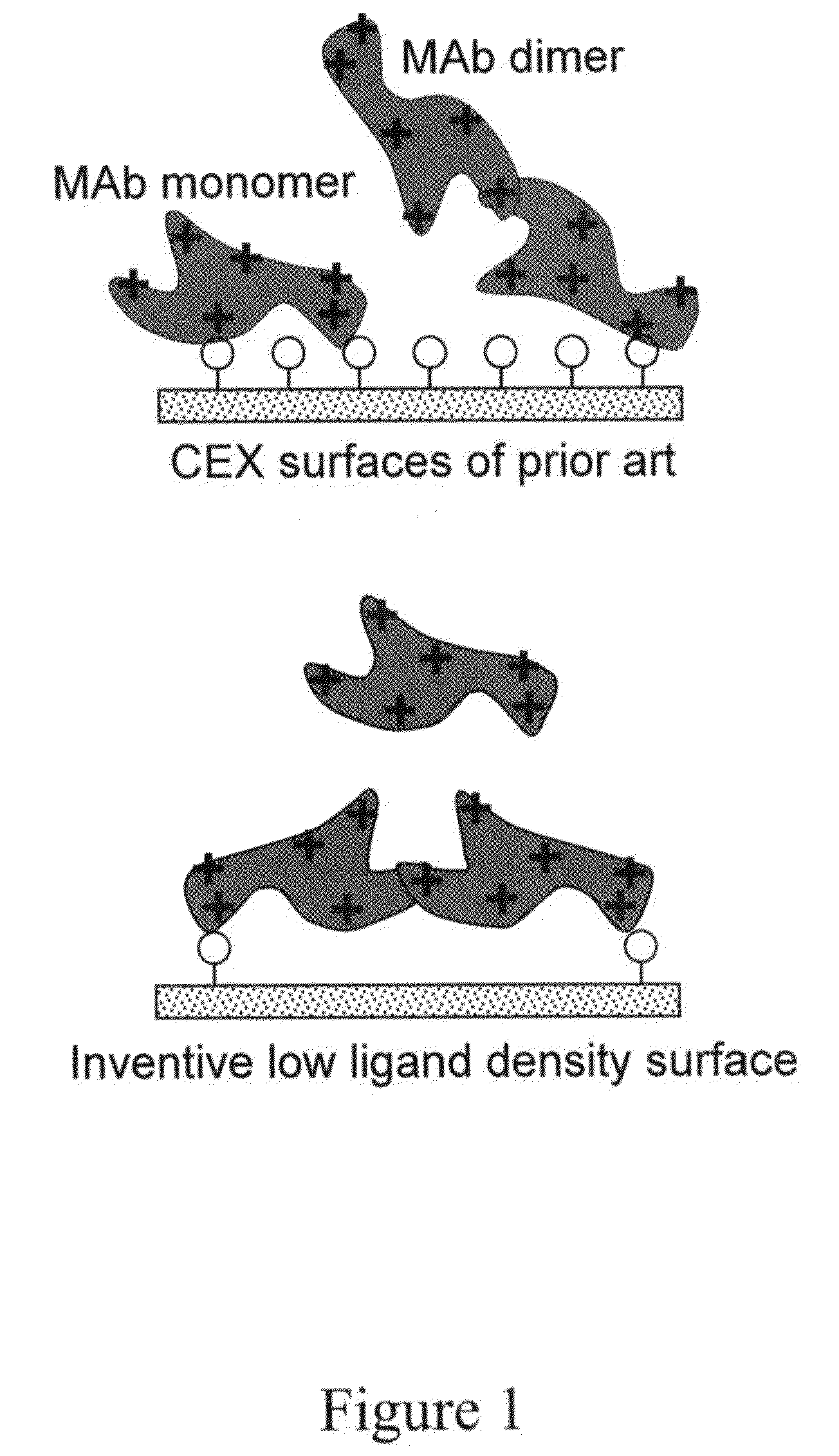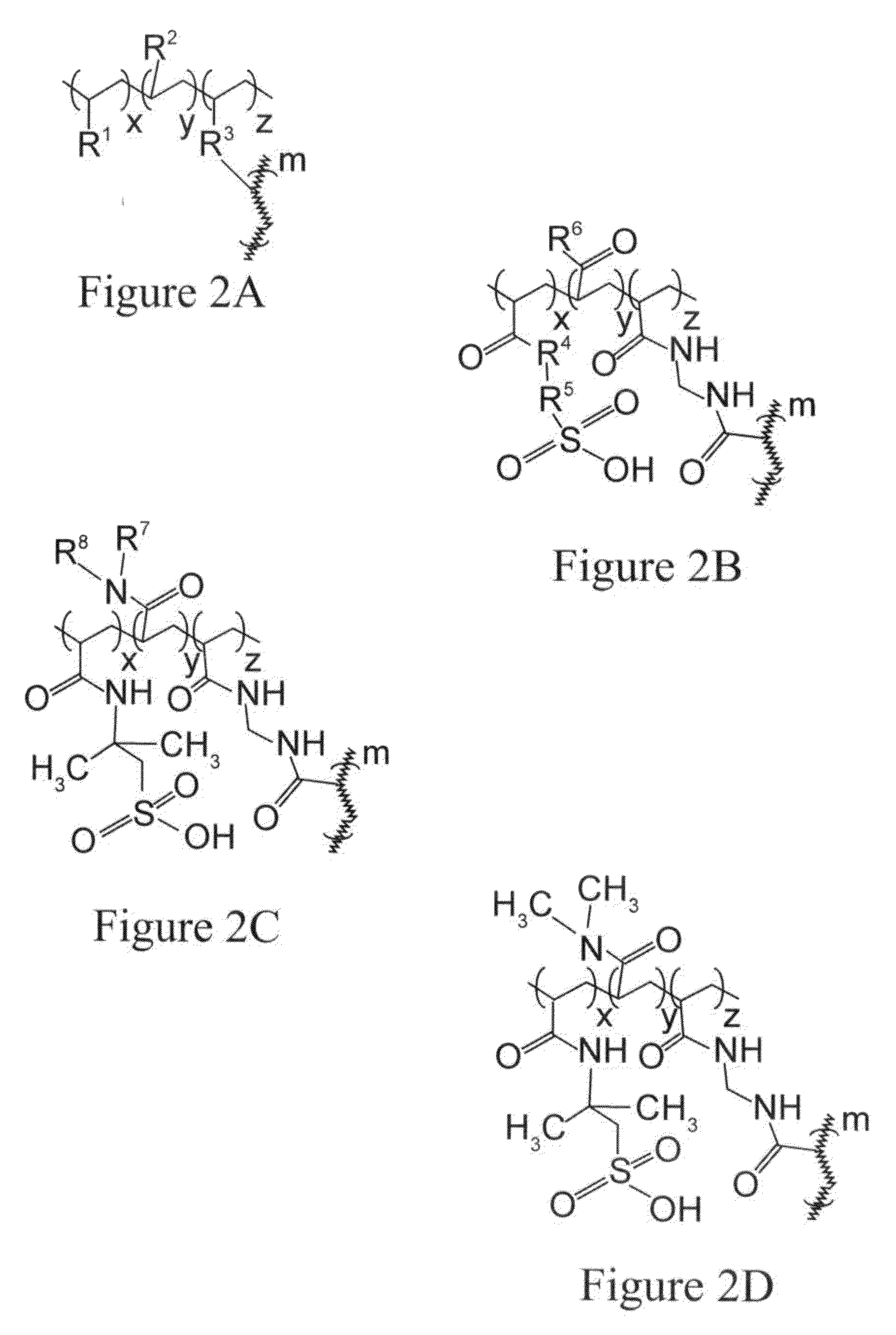Removal of protein aggregates from biopharmaceutical preparations in a flow-through mode
- Summary
- Abstract
- Description
- Claims
- Application Information
AI Technical Summary
Benefits of technology
Problems solved by technology
Method used
Image
Examples
example 1
Preparation of Cation-Exchange (CEX) Surface-Modified Membrane
[0156]In this experiment, a series of CEX surface-modified membranes were prepared with a variable density of binding groups, which in this case are negatively charged sulfonic acid residues. The density of the cation exchange groups was controlled by formulation of reactive solution used for surface modification. In order to achieve a lower density, an uncharged reactive monomer, N,N-dimethylacrylamide, was added in different amounts.
[0157]A series of aqueous solutions were prepared containing 2-acrylamido-2-methylpropanesulfonic acid (AMPS) ranging from 0 to 4.8% wt., N,N-dimethylacrylamide ranging from 0 to 4.8% wt., and 0.8% wt. of N,N′-methylenebisacrylamide. A hydrophilic ultra-high molecular weight polyethylene membrane with pore size rating of 0.65 um and a thickness of 0.125 mm was cut into square pieces of 14 cm by 14 cm and each piece was submerged in one of solutions for 30 seconds to ensure complete wetting. ...
example 2
Analysis of Aggregate Binding Selectivity Using Static Capacity Measurements
[0159]In this experiment, CEX membranes with varied density of binding groups prepared in Example 1, were tested for their selectivity for binding protein monomers and protein aggregates.
[0160]A 2 g / L solution of a partially purified monoclonal antibody, referred to as MAb I, containing about 15% aggregates was prepared in 50 mM Sodium Acetate buffer, pH 5.0. A 14 mm membrane disk was pre-soaked in the acetate buffer and then transferred to 0.5 mL of antibody solution. The solution vials were gently shaken for 15 hours, and the molecular weight species left in solution were analyzed by Size-Exclusion Chromatography. The results are presented in Table 2.
[0161]While the generally low yields of MAb indicates that the membranes have been loaded at below capacity in this experiment, one of the variants, Membrane 7, demonstrated practically complete removal of dimers and high molecular weight (HMW) aggregates. Thi...
example 3
Removal of Aggregates in Flow-Through Mode for a Partially Purified Monoclonal Antibody (MAbI)
[0162]In a representative experiment, successful use of the membranes according to the present invention for the removal of protein aggregates from a sample containing a monoclonal antibody in flow-through mode, was demonstrated.
[0163]Five layers of membrane 7 from Example 1 were sealed into a vented polypropylene device, with a frontal membrane filtration area of 3.1 cm2 and membrane volume of 0.2 mL. This type of device is referred to below as the “Micro” device. A purified MAb I at 4.5 g / L was dialyzed into pH 5.0, 50 mM acetate buffer. The resulting material, referred to as partially purified MAb I, was diluted to a concentration of 1 g / L Mab I with 5% aggregates, in pH 5, 50 mM acetate with a conductivity of ˜3.0 mS / cm. The material (about 80-100 mL) was then passed through 0.2 mL devices containing either membrane 7 or 8 from Example 1, or a 0.18 mL Acrodisk device containing Pall Mus...
PUM
| Property | Measurement | Unit |
|---|---|---|
| Fraction | aaaaa | aaaaa |
| Fraction | aaaaa | aaaaa |
| Electrical conductivity | aaaaa | aaaaa |
Abstract
Description
Claims
Application Information
 Login to View More
Login to View More - R&D
- Intellectual Property
- Life Sciences
- Materials
- Tech Scout
- Unparalleled Data Quality
- Higher Quality Content
- 60% Fewer Hallucinations
Browse by: Latest US Patents, China's latest patents, Technical Efficacy Thesaurus, Application Domain, Technology Topic, Popular Technical Reports.
© 2025 PatSnap. All rights reserved.Legal|Privacy policy|Modern Slavery Act Transparency Statement|Sitemap|About US| Contact US: help@patsnap.com



